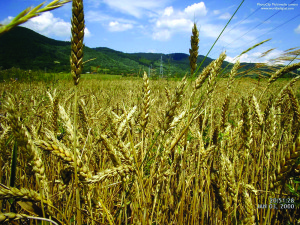 Dietary fibre is essential to good health and disease prevention.
Dietary fibre is essential to good health and disease prevention.
Research shows that a diet high in fibre can reduce the risk of developing type 2 diabetes, coronary heart disease, bowel and breast cancer, gallstones, diverticular disease and weight gain1-6. It also seems that some fibres are better at doing this than others.
What is dietary fibre?
Dietary fibre is the structural part of plants and plant tissue forming the skeleton and cell walls. It is more abundant on the outside of plants and thus is often removed during milling and food processing. While there are many kinds of dietary fibres the one thing that they share in common is that they are not digested or absorbed as they pass through the gut.
Types of fibre
Soluble fibre
This provides nutrients for colonic bacteria that increase microbial growth and help produce volatile fatty acids; such as butyrates, which are protective of colonic mucosa. Soluble fibre is greater in whole fruit (as opposed to fruit juices or peeled fruit) and is also found in vegetables, legumes, nuts, oats and barley.
Insoluble fibre
This increases stool bulk through the absorption of water into its structure. This helps the stools to soften and decrease their transit times through the gut. It also binds fat soluble carcinogens and removes them from the body. Insoluble fibre is found in cereals e.g. wheat, rice and bran and cereal products such as bread, breakfast cereals and pasta.
The main role of dietary fibre
The natural properties of fibre improve digestion and help to reduce the risk of developing many diseases that affect our long-term health.
- Faecal bulking which helps to prevent constipation
- Increases satiety i.e. it is filling so aids weight reduction
- Aids blood sugar control by slowing the rate of absorption of sugar from the gut into the blood stream, thereby releasing glucose into the blood more slowly This improves blood sugar control and providing energy for a longer period of time. This is particularly important to those with Diabetes and weight control issues.
- Fibre absorbs water in the gut and helps prevent diarrhoea
- It reduces fat absorption because fibre absorbs and removes bile acids and salts from the body, this not only reduces fat absorption aiding weight control but also improves cholesterol control
- It helps bowel regularity. Maintaining a diet high in fibre speeds up the transit time of food through the bowel, reducing the risk of haemorrhoids, diverticular disease and colon cancer.
- Fibre reduces mortality– Cereal fibre has been shown to reduce total mortality and mortality rates of cancer and coronary heart disease by around 20%.5
- It reduces the risk of developing type 2 diabetes by 28-37% when cereal fibre is increased. 6
- Fibre reduces the risk of colorectal cancer by up to 10% with each 10gm increase in cereal fibre intake.7Constipation can also be reduced when fibre increases because it increases faecal bulk making stools softer and easier to pass.
- A reduced risk of developing coronary heart disease can be achieved by an estimated 14% with each 10gm increase in dietary fibre.8 It has been found that the soluble fibre in oats and barley lower total and LDL-cholesterol by around 5% when just 6g/day is added to the diet.9,10
- Weight loss is easier to maintain. The Nurse’s Health study, which tracked the diets of 74,000 healthy women over 12yrs, found those with a higher fibre intake gained less body weight. A 12gm increase in total dietary fibre intake was associated with 3.5kg less weight gain over 12years.11
- A similar study The Health Professional Follow-up study found a 20gm increase in total dietary fibre intake was associated with 5.5kg less weight gain over 8 years.12
- Waist circumference can be reduced when total fibre from cereals, fruits and vegetables increase. 13
How much do we need?
The national recommendation is for the following:
Children Age +5g (e.g. 5yr old requires 10g)
Adult women 25g
Adult men 30g
However currently the levels for women are 17.5g/day and 22.1g/day for men. So we all need to work a lot harder at improving our fibre intake.
A word of caution
A moderate increase in dietary fibre to the levels outlined for age will certainly benefit health however more is not better. Excessive levels of dietary fibre can lead to the leaching of key minerals such as calcium, iron and zinc. Athletes or those consuming large volumes of carbohydrate rich foods need to be particularly careful not to eat in excess of guidelines as it can lead to diarrhoea, flatulence and bloated feelings.
Care should also be taken with young children(particularly if they are underweight) as fibre is filling and can suppress appetite for protein rich foods that are important for growth and development.
How much dietary fibre is in foods?
Choosing foods highest in fibre and lowest in energy can help guide you to better weight control.
| Food |
Fibre |
Energy |
|
Food |
Fibre |
Energy |
| Bread med slice |
g |
kcal/kJ |
Cereals 1/2 cup |
g |
kcal/kJ |
|
| White |
0.79 |
68/287 |
San Bran® |
10.9 |
79/334 |
|
| Wholemeal |
1.6 |
53/224 |
All Bran® |
7.3 |
79/333 |
|
| Whole grain |
0.72 |
54/226 |
Porridge |
1 |
62/262 |
|
| Fibre white® |
1.12 |
71/300 |
Muesli |
5.7 |
161/674 |
|
| Burgen ® |
2.05 |
82/342 |
Weetbix® x2 |
5 |
105/441 |
|
| Molenburg® |
2 |
68/285 |
||||
| Cream cracker x2 |
0.28 |
77/323 |
Vegetables 100g | |||
| Crispbread x2 |
1.18 |
45/188 |
Tomato |
1.2 |
16/68 |
|
| Coleslaw |
1.5 |
94/397 |
||||
| Legumes 100g | Carrot boiled |
3.2 |
26/112 |
|||
| Lentils |
1.9 |
88/370 |
Pumpkin |
1.1 |
44/188 |
|
| Lima beans |
5.2 |
94/396 |
Green peas |
4.5 |
51/216 |
|
| Kidney beans |
5.9 |
100/422 |
Green beans |
1.95 |
18/79 |
|
| Chick peas |
3.2 |
102/429 |
Broad beans |
6.7 |
57/242 |
|
| Mix bean salad |
5.2 |
83/350 |
Cauliflower |
2 |
20/84 |
|
| Baked beans |
5.7 |
83/351 |
Brocoli |
3.2 |
26/113 |
|
| Haricot beans |
6.1 |
90/380 |
Potato |
1.7 |
81/347 |
|
| Soy bean sprouts |
2.5 |
140/587 |
Spinach |
2.1 |
21/92 |
|
| Fruit each | Nuts 50g | |||||
| Apple |
1.9 |
75/314 | Brazil |
2.1 |
338/1415 |
|
| Pear |
3 |
76/321 | Almonds |
3.6 |
304/1275 |
|
| Banana |
1.8 |
131/551 | Walnuts |
2.5 |
349/1465 |
|
| Orange |
1.3 |
51/215 | Hazil |
3.6 |
312/1310 |
|
| Kiwi |
1.6 |
45/190 | Pistachio |
2.9 |
311/1305 |
|
| Tamarillo |
1.9 |
18/78 | ||||
| Feijoa |
1 |
11/46 | Seeds 2Tb | |||
| Pineapple 1 slice |
1.3 |
53/222 | Sunflower |
1.3 |
139/582 |
|
| Watermelon 1 slice |
0.4 |
49/208 | Pumpkin |
2 |
221/928 |
|
| Flaxseed |
10 |
311/1305 |
Ref: Food works 2009
(For practical purposes single servings have been used where possible).
Dietary tips to improve your fibre intake
Becoming more aware of the practical ways you can boost your fibre intake each day can greatly improve your long-term health.
- Eat a high fibre cereal at breakfast. Just ½ cup bran/day can give up to 10gm fibre
- Choose whole grain breads, rice and pasta rather than white varieties
- Avoid reducing the natural fibre content by peeling or juicing fruits and vegetables
- Use vegetables to replace fat by adding more of the things you eat e.g add vegetables to casseroles and reduce the meat; reduce the cheese in pizza, quiches, toasted sandwiches, Panini etc by adding more tomato, onion, corn, spinach or leftover vegetables.
- Legumes and cereals contribute the most fibre per serving however fibre is accumulative so while bread may only be 2-3 gms per slice eating 3-4 slices the fibre will soon add up.
- For people who are gluten or wheat intolerant, but still keen to boost their fibre intake, rice bran is a suitable alternative to wheat or oat bran.
- As beans, peas and lentils also contain protein these can be used to replace meat meals 2-3 times per week. This can benefit heart health by reducing saturated fat. For serving ideas the Heart Foundation is offering free down loads of its recent Full O’ Beans Cook book
http://www.heartfoundation.org.nz/blog-stories/blog/full-o-beans-free-cookbook-launched
For an assessment of your dietary fibre intake and advice on things you may need to change for better health contact us today.
References
- Dong J, He K, Wang P and Qin L. Dietary fibre intake and risk of breast cancer: a meta-analysis of prospective cohort studies. Am J Clin doi: 10.3945/ajcn.111.015578
- Mendez-Sanchez N, Zamora-Valdes D, Chavez-Tapia NC, Uribe M. Role of diet in cholesterol gallstone formation. Clin Chim Acta. 2007 Feb:376 (1-2): 1-8.
- Strate LL. Lifestyle factors and the course of diverticular disease. Dig Dis. 2012;30 (1):35-45.
- Liu S, Willet WC, Manson JE, Hu FB, Rosner B, Colditz G. Relation between changes in intakes of fibre and grain products and changes in weight and development of obesity among middle-aged women. Am J Clin Nutr 2003;78(5)920-27
- Park Y, Subar AF, Hollenbeck A, Schatzkin A. Dietary fibre intake and mortality in the NIH-AARP diet and health study. Arch Intern Med. 2011 Jun 27; 171 (12):1061-8 Epub 2011 Feb 14.
- Priebe MG, van Binsbergen JJ, de Vos R, Vonk RJ. Whole grain foods for the prevention of type 2 diabetes mellitus. Cochrane Database Syst Rev 2008 (1): CD006061
- Norat T, Kampman E, Greenwood D, Vieira R, Lau R, Chan D, Aune D. Dietary fibre, whole grains and risk of colorectal cancer systematic review and dose response meta-analysis of prospective studies. BMJ 2011; 343:d6617.
- Pereira MA, O’Reilly E, Augustsson K, Fraser GE, Goldbourt U, HeitmannBL,et al. Dietary fiber and risk of coronary heart disease: a pooled analysis of cohort studies. Arch Intern Med 2004:164 (4):370-6.
- Truswell A Cereal grain and coronary heart disease. Eur J Clin Nutr 2002;56(1):30-42.
- Brown L, Rosner B, Willett WW, Sacks FM Cholesterol lowering effects of dietary fiber: a meta-analysis Am J Clin Nutr 1999;69 (1):30-42.
- Liu S, Willett WC, Manson JE, HU FB, Rosner B, Colditz G. Relation between changes in intakes of dietary fibre and grain products and changes in weight and development of obesity among middle aged women. Am J Clin Nutr 2003:78 (5):920-27.
- Koh-Banerjee P, Franz M, Sampson L, Liu S, Jacobs DR, Jr, Spiegelman D et al. Changes in wholegrain, bran, cereal fibre consumption in relation to 8 year weight gain among men. Am J Clin Nutr 2004;80 (5):1237-45.
- Du H et al. Dietary fibre and subsequent changes in body weight and waist circumference in European men and women. Am J Clin Nutr 2010:91: 329-36.































































Leave a Reply